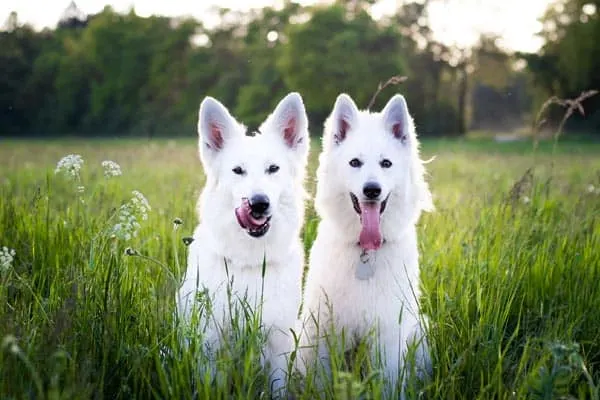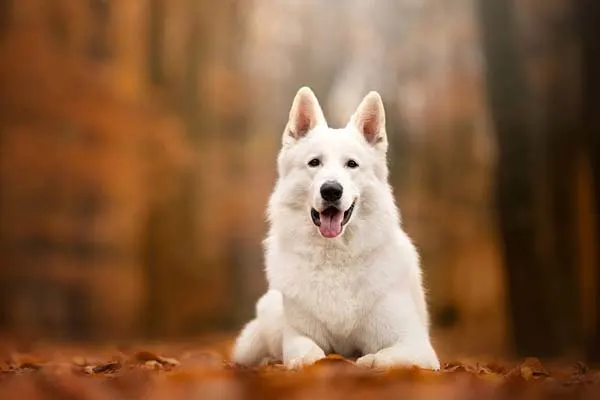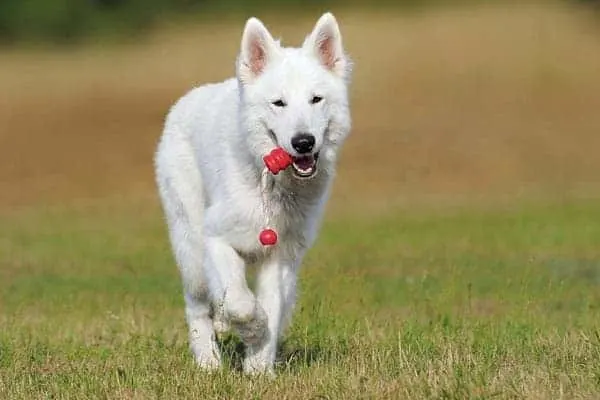White German Shepherd: Why The Stunning Is So Confusing?
So many times a dog’s color can help you identify its breed. American Eskimos are white, and Belgian Sheepdogs are black.
Similarly, West Highland Terriers are universally white, while we usually associate Scotties as being black, and Cairn Terriers as brindle.
Dutch Shepherds are almost always brindle, while German Shepherds and the Belgian Malinois rarely are. German Shepherds are usually black and tan, right?
I remember the first time I saw a real-life white German Shepherd. I knew White Shepherds existed but was not prepared for how strikingly unusual they appeared.
For a long time, I believed White Shepherds to be genetic anomalies that were the result of intensive inbreeding and prone to disease.
In this article, we dispel much of the myth surrounding the white German Shepherd, and resolve some of the mystery.
If you ever saw a White Shepherd and thought it was a separate breed, you would not be completely wrong.
The white German Shepherd is a color variation of the German Shepherd. However, since the AKC-sanctioned shows disqualify white German Shepherds, fanciers have established a separate set of standards and continue to run conformation shows based on their breed clubs.
Feeling that the American Show lines are now endangering the esteemed qualities of the GSD, White Shepherd breeders have in many cases established a distinct line.
Where Did The White German Shepherd Originate?

We know the German Shepherd came from Germany, but what about the White Shepherd?
White was actually among the original colors of German Shepherds. Max von Stephanitz named Horand von Grafrath as the first registered GSD and in this dog’s ancestry was a White German Shepherd named Greif.
Greif was Horand’s ‘grandfather’ on the mother’s side, and Greif appeared on the Hanoverian show circuit twice in the 1880s.
Berno v.d.Seeweise was a white GSD from one of Horand’s son’s litters, illustrating the existence of a recessive white gene.
Von Stephanitz did not include color preferences in the breed standard, emphasizing that they did not affect the working quality of the German Shepherd.
Moreover, herders ensured the persistence of white German Shepherds because light-colored dogs were easy to distinguish from dark sable wolves amongst their sheep.
Although not widely known, Nazi Germany actually began a systematic effort to eradicate the white GSD, and also exercised their heavy influence on the SV, the German Shepherd registry.
Germans were concerned about perceived genetic health issues linked to the lighter colors, and were plagued by the idea that white caused the vivid coats they preferred to fade.
Later advances in DNA research would prove that Germany’s fears were unfounded regarding the white German Shepherd.
White Shepherds owe their modest prominence to the fact that they gained a following in North America.
Despite Canadian and American white German Shepherd proponents, the AKC bowed to foreign influence and disqualified the white coat color for the GSD conformation ring in 1968.
What Is The Breed Standard For The White Shepherd?
White German Shepherds have most of the breed characteristics you would expect to see in a GSD. The selection for white coats has inevitably led to subtle shifts.
White Shepherds should have a stable temperament
White Shepherds should have the self-confidence and work ethic that any GSD would. Club judges do not tolerate shyness, fearfulness, or aggression.
White Shepherds can be aloof with strangers, but once they become familiar with someone, they usually are cordial.
The emphasis on the White Shepherd revolves around its working ability, which is an attempt to remain true to the original intention of founder Max von Stephanitz.
Not only should a White Shepherd have the ability to work, but it should visibly enjoy any tasks, while showing focus and excellent execution.
White Shepherds have slight physical differences
One of the German Shepherd’s most distinguishing features is its head. The muzzle and skull are the same lengths, and the head is proportional to the dog’s body.
The stop, or dip from forehead to muzzle, should be moderate with no wrinkles or furrows in the forehead.
White Shepherds do not have the dome-shaped skull that standard German Shepherds do. They also have brush-like tails that hang to their hocks and should curve slightly upward at rest.
Their ears are medium, triangular, and upright. As in any Shepherd, White GSDs can occasionally have weak ears that may flop. Despite their white color, these dogs should have dark brown eyes and black noses, lips, and eye rims.
A White Shepherd’s pigmentation prevents any confusion with albinism, and similarly to the working East German and Czech lines, they are only slightly longer than they are tall.
White Shepherds are marginally smaller than their standard color counterparts. Male White Shepherds are 24 to 26 inches tall and females stand 22 to 24 inches at the shoulders.
The white GSD’s weight ranges from 60 to 85 pounds, and there is an expectation of a clear distinction between the genders.
A White Shepherd’s topline is only slightly sloping from shoulders to hindquarters. Probably in an effort to prevent some of the exaggerations seen in show lines, the White Shepherd standard has strict guidelines for certain angulations.
The shoulders must lay at about 35 degrees to vertical, and the croup (the flat area from the start of the hips to the beginning of the tail) should be at the same angle.
Critics say show line breeders often focus too much on their dogs’ hocks and knees, resulting in a croup that is way too steep for working efficiency.

The White Shepherd has a signature coat
Like any German Shepherd, the White Shepherd should have a double coat.
The outer hairs should be short or medium-long and coarse, laying flat, and protecting your dog from wind, moisture, and ultraviolet rays. Your dog’s undercoat will be dense, short, and soft.
White Shepherds often have a ruff of longer hair around the neck and plumes on the underside of the tail and backs of the forelegs and hind legs if their hair is long enough.
White Shepherd owners and show ring judges do prefer pure white dogs, however, White Shepherds can display a range of shades.
- Snow white – most desired
- Beige
- Off-white
- Cream
An albino dog is not a White Shepherd, and judges will disqualify any evidence of albinism.
- Blue or pink eyes
- Pink nose
- Lack of pigmentation of lips, skin, paw pads, or eye rims
- Translucent skin
The White Coat Of A German Shepherd Is Not Diluted
Dilution can occur on two separate genes in German Shepherds and results in the inability to express black in liver dogs, or partial dilution of black in blue Shepherds. Dogs with both dilution expressions are Isabella, a diluted liver.
White color in a German Shepherd is not a dilution but the expression of a recessive gene just like black is. White manifests because the recessive gene is a masking allele that prevents the expression of standard colors.
For example, a White Shepherd can be genetically black and tan, but the masking gene will make the dog appear white.
Another way to understand the white color in Shepherds is to consider two major locations on a dog’s chromosomes that are responsible for the expression of coat color.
The Agouti or “A” allele dictates the base color and the “E” allele determines how the base color appears.
The “A” allele
An allele refers to a gene and names its specific location. The “A” allele is responsible for the base colors of many breeds of dogs.
- “aw” – Wild or wolf sable; blend of reds, yellows, and grays resembling a wolf’s coat; relatively rare in dog breeds, common in Spitz types.
- “at” – black and tan; also responsible for tricolor in breeds other than the GSD. Black and tan dogs include the classic saddle pattern, extended saddle, blanket, and bicolor.
- “a” – recessive black.
Each dog carries alleles in pairs and passes on one gene to each of their offspring – how a parent passes genes to a puppy is random.
In order of dominance, “aw” is dominant over “at” and “a”, while “at” is dominant over “a”.
The dominant trait will show up or express if it is present. As an illustration, if a dog has a wild sable gene and a black and tan gene, it will be sable.
The “E” allele will influence the expression of black on the “A” allele. “A” can exist as dominant black, and “ay” as golden or fawn, but neither exists in the German Shepherd breed.
- “Em” – Dog has a black facial mask
- “E” – No facial mask; uncommon in the GSD but possible
- “e” – No expression of black
In order for the GSD to be white, the intensity locus (or allele) also has an inability to produce red in addition to the “E” locus being devoid of black. Otherwise, dogs with two recessive “e” genes would be tan or reddish.
Some white dogs may actually have red or tan showing through in areas like the ears and along the back.
In a nutshell, color genetics gives standard German Shepherds the following specific coats:
Black and Tan or Bicolor (only minor points of tan or red)
- A locus – at/at or at/a
- E locus – Em/Em, Em/E, Em/e, E/e, E/E
Sable
- A locus – aw/a, aw/aw, or aw/at
- E locus – Em/Em, Em/E, Em/e, E/E, or E/e
Some experts use separate allele markers for dogs with a saddle (“as”) and those with minimal tan or red points (“at”). Black and tan saddles are dominant over bi-colors, and extended saddles or blankets are between the two, as theorized by Jmadesign.com.
Black
- A locus – a/a
- E locus – Em/Em, E/E, Em/E, Em/e, or E/e
White
- A locus – aw/a, a/a, at/at, aw/at
- E locus – e/e
Note how both black and white are recessive colors in the GSD. A black dog has two copies of the recessive “a” gene. A White Shepherd has two of the recessive “e” alleles preventing any expression of black.
The White Shepherd Is Still A German Shepherd

Although there are people who would like to promote the idea of a separate breed, White Shepherds have most of the characteristic features of standard GSDs.
- Shed moderately year-round with a heavy loss of undercoat twice a year.
- Need brushing two to three times per week.
- Require up to two hours of exercise daily, best split into at least two sessions.
- Mental stimulation, reinforced training, and socialization are key to raising a well-behaved White Shepherd.
- White Shepherds have the potential for dog aggression. Socialization and neutering can help your Shepherd get along better with other dogs.
- Your White Shepherd is a versatile working dog, well-suited for many activities such as police work, guide, therapy, search and rescue, agility, and herding.
- White Shepherds are good family pets that require consistent time and attention to prevent boredom, destructiveness, anxiety, and aggression.
How The White Shepherd May Differ From Other GSDs
Some breeders have taken advantage of the fact that White Shepherds cannot participate in AKC conformation shows, and have attempted to make improvements without having to obsess over their dog’s looks.
Some lines of White Shepherds are less intense and more docile than standard German Shepherds. They can also be more nervous, and have issues with shyness and fear-biting.
White Shepherds Are Not Inherently Unhealthy
White Shepherd breeders have also tried to select for better hips, and fought to maintain fairly level toplines and unexaggerated joint angles. White German Shepherds still struggle with a few health issues common to the Alsatian breed.
- Epilepsy – Affected dogs have seizures for no known reason.
- Degenerative myelopathy – A devastating neurologic disease that, while not painful, is progressive and leads to paralysis.
- Pannus – inflammatory condition of the cornea, or outer layer of the eye.
- Hip dysplasia
- Elbow dysplasia
- Skin allergies or atopy
- GDV (gastric dilatation and volvulus) – The stomach swells from gas or fluid and can twist; The Shepherd’s large chest depth to body height ratio makes it particularly vulnerable to bloat.
Do Breed Clubs Clarify Your Understanding Of The White GSD?
Although we have used the terms White Shepherd and white German Shepherd interchangeably, not all circles see it that way.
In fact, the American Kennel Club and the Canadian Kennel Club allow registration of the German Shepherd Dog regardless of color.
So although you cannot show your white German Shepherd in conformation, you can participate in any other events and competitions sponsored by the respective registries. White German Shepherd Dogs are eligible for full papers indicating a pedigree status.
The United Kennel Club recognized the White Shepherd as a separate breed as of 1999. However, you can register a UKC White Shepherd in the AKC and CKC as a white German Shepherd Dog as well.
White Shepherds have a slightly different standard than the German Shepherd Dog.
You will note above that some promoters of the white German Shepherd have implemented subtle variations in their breed standards for disposition and physical characteristics, which have become important distinctions for the official White Shepherd.
Alternatively, you also have the option of registering your white GSD in the UKC as a white German Shepherd, and allow it to compete in conformation shows against other GSDs of standard colors.
White German Shepherds have a legacy
The White Shepherd has fundamentally contributed to the existence of two prominent designer dogs, and a new European breed.
Shiloh Shepherd and King Shepherd
Shiloh Shepherds look like overgrown German Shepherds which is not far from the truth. Shilohs were formulated in the United States in the 1980s by Tina Barber to address some of the health issues that were appearing in purebred German Shepherds.
The Shiloh Shepherd began as a selective process of breeding large German Shepherds with good hips.
Eventually, crossbreeding with a Canadian White Shepherd, Czechoslovakian Wolfdogs, and Alaskan Malamutes, among others, began in order to expand the gene pool, increase size, and further improve the hips.
Shiloh Shepherds are often black and tan but can be an assortment of other colors, frequently sporting a black saddle. They can also be solid black or solid white.
King Shepherds resulted from backcrossing Shiloh Shepherds with German Shepherds, creating another giant Alsatian look-alike.
White Swiss Shepherd Dog
Switzerland developed the White Swiss Shepherd Dog, or Berger Blanc Suisse, from an American White Shepherd they imported in the early 1970s.
The Swiss Stud Book registered the first Swiss White Shepherd Dog in 1991, and the FCI accepted the breed for provisional registration in 2002.
In 2011 the FCI, also known as the World Canine Association, officially recognized the Swiss White Shepherd Dog.
The UKC does not distinguish the Berger Blanc Suisse from the White Shepherd. Moreover, the American Kennel Club does not make any distinction between the White Shepherd and Swiss White Shepherd Dog, considering both to be variations of the GSD.
Differences between the White Shepherd and Swiss White Shepherd Dog are largely temperamental, with the Swiss variety being even more docile and mellow.
Our YouTube Video: The Stunning White German Shepherd
Summary – Comparison of Colors to White
Wild or Wolf Sable
Some dogs will look even more wolf-like than this dog that has the suggestion of a blanket. Notice for the most part there is not a clearly-demarcated pattern of colors.
Wolf sable or “aw” is dominant to the other agouti-class colors in the GSD like black and tan, black, and bi-color.
Bicolor
Bicolor dogs are dark with only minor points of color. Notice how large these dogs are. They are examples of where a breeder would start to select for a giant-sized GSD.
The darker dog is a black and tan bicolor, while the other looks like a dark sable.
White German Shepherd
This dog has a flatter head than the slight dome of the standard GSD which gives the muzzle less of a square shape.
A normal variation of the German Shepherd type, White Shepherd breeders have likely selected for less of a dome which leads to a more fox-like appearance to the face.
The dog in the video also has a rather short coat. You can see a noticeable ruff on the neck and shoulder region, and longer hairs on the underside of the tail but not much evidence of plumes on the backs of the hind legs. The topline is fairly level.
Another white German Shepherd better illustrates longer hairs on the hind end, but again, this dog’s fur is relatively short. Note the large clumps of undercoat removed by the rake.
Working Swiss White Shepherd Dog
This dog better illustrates the medium-long coat in the White Shepherd Club breed standard with plumes on backs of hindlegs and forelegs and under the tail. Also, the head is flatter than in the typical German Shepherd.
The dog is an attentive worker. Despite the differences, you can readily recognize the Swiss White Shepherd Dog as a German Shepherd type.






























